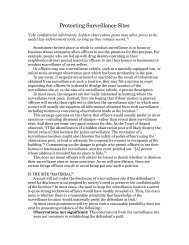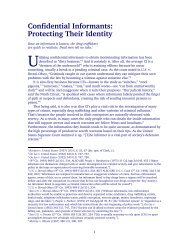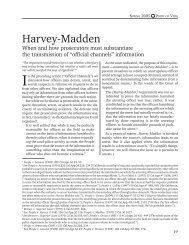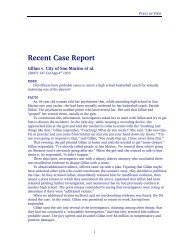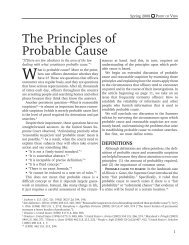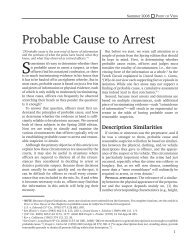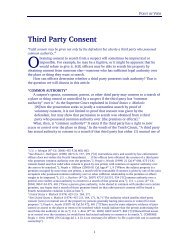Executing Search Warrants - Alameda County District Attorney's Office
Executing Search Warrants - Alameda County District Attorney's Office
Executing Search Warrants - Alameda County District Attorney's Office
You also want an ePaper? Increase the reach of your titles
YUMPU automatically turns print PDFs into web optimized ePapers that Google loves.
It may also be based on the large quantity of items on the premises, especially if the<br />
property was of a type that is commonly stolen; e.g., TV’s, cell phones, jewelry. 127 As<br />
noted earlier, this is what happened in People v. Williams 128 where officers who were<br />
executing a warrant for drugs discovered “an inordinate amount of television sets, video<br />
cassette recorders, stereo equipment, clocks, firearms, silverware and other household<br />
items.” In ruling the seizure of these items was lawful, the court noted that the officers<br />
“knew from experience that firearms and electronic equipment are among the ‘hottest’<br />
items encountered by the burglary detail.”<br />
If officers anticipate finding property that was stolen from a certain person, they may<br />
arrange to have that person accompany them and watch as they search. And if he sees<br />
any of his property, officers may seize it even if it was not listed in the warrant. 129 For<br />
example, in People v. Superior Court (Meyers) 130 officers obtained a warrant to search<br />
Meyers’ house for property taken in a residential burglary. The victims of the burglary<br />
accompanied the officers and, during the course of the search, identified several dozen<br />
unlisted items that had been stolen from them. The officers seized those items and, on<br />
appeal, the California Supreme Court ruled the procedure was lawful.<br />
There are, however, two limitations in victim-assisted searches. First, the victim may<br />
not do any searching. Instead, he must be instructed to simply watch as officers conduct<br />
the search for listed evidence and notify them if he sees any of his property. 131 Second, if<br />
a victim identifies an item, officers may not seize it until he has explained how he was<br />
able to identify it. Although the victim need not provide a lengthy or elaborate<br />
explanation, something more than “That’s mine” is required; e.g., “I recognize it because<br />
of the design.” 132<br />
If the warrant authorizes a search for property that cannot be identified without<br />
assistance from an expert, an expert may accompany officers when they execute the<br />
warrant and may, if necessary, conduct the search himself while officers watch. 133<br />
For example, in People v. Superior Court (Moore) 134 officers in Santa Clara <strong>County</strong><br />
were investigating an attempted theft of trade secrets from Intel Corp. During the course<br />
of the investigation, they obtained a warrant to search the suspect’s business for several<br />
computer-related items, such as a “Magnetic data base tape containing Intel Mask data<br />
or facsimile for product No. 2147 4K static Ram.” The affiant realized he would need a<br />
computer expert to identify the listed items, so he obtained authorization from the<br />
somewhat relevant]; People v. Guajardo (1994) 23 Cal.App.4 th 1738, 1742; People v. Bush (2001)<br />
88 Cal.App.4 th 1048, 1052-3; United States v. Harris (1971) 403 US 573, 582-3 [officers may also<br />
consider the suspect’s reputation].<br />
127 See People v. Martin (1973) 9 Cal.3d 687, 696; People v. Wolder (1970) 4 Cal.App.3d 984, 994;<br />
In re Donald L. (1978) 81 Cal.App.3d 770, 775; In re Curtis T. (1989) 214 Cal.App.3d 1391 [large<br />
quantity of car stereo equipment piled on the floor].<br />
128 (1988) 198 Cal.App.3d 873.<br />
129 See Wilson v. Layne (1999) 526 US 603, 611-2 [“Where the police enter a home under the<br />
authority of a warrant to search for stolen property, the presence of third parties for the purpose<br />
of identifying the stolen property has long been approved by the Court and our common-law<br />
tradition.”]; Penal Code § 1530; People v. Tockgo (1983) 145 Cal.App.3d 635, 645; People v.<br />
Carpenter (1997) 15 Cal.4 th 312, 364.<br />
130 (1979) 25 Cal.3d 67.<br />
131 See People v. Tockgo (1983) 145 Cal.App.3d 635, 645, fn.6 [For various reasons “there is a risk<br />
that some victims will lead the police to unnecessarily broaden or lengthen the search or to seize<br />
property not actually stolen from them.”]; People v. Superior Court (Meyers) (1979) 25 Cal.3d 67,<br />
84-5 [dis.opn. of Mosk J.).<br />
132 See People v. Superior Court (Meyers) (1979) 25 Cal.3d 67, 75, fn.6.<br />
133 See Penal Code § 1530.<br />
134 (1980) 104 Cal.App.3d 1001.<br />
22



